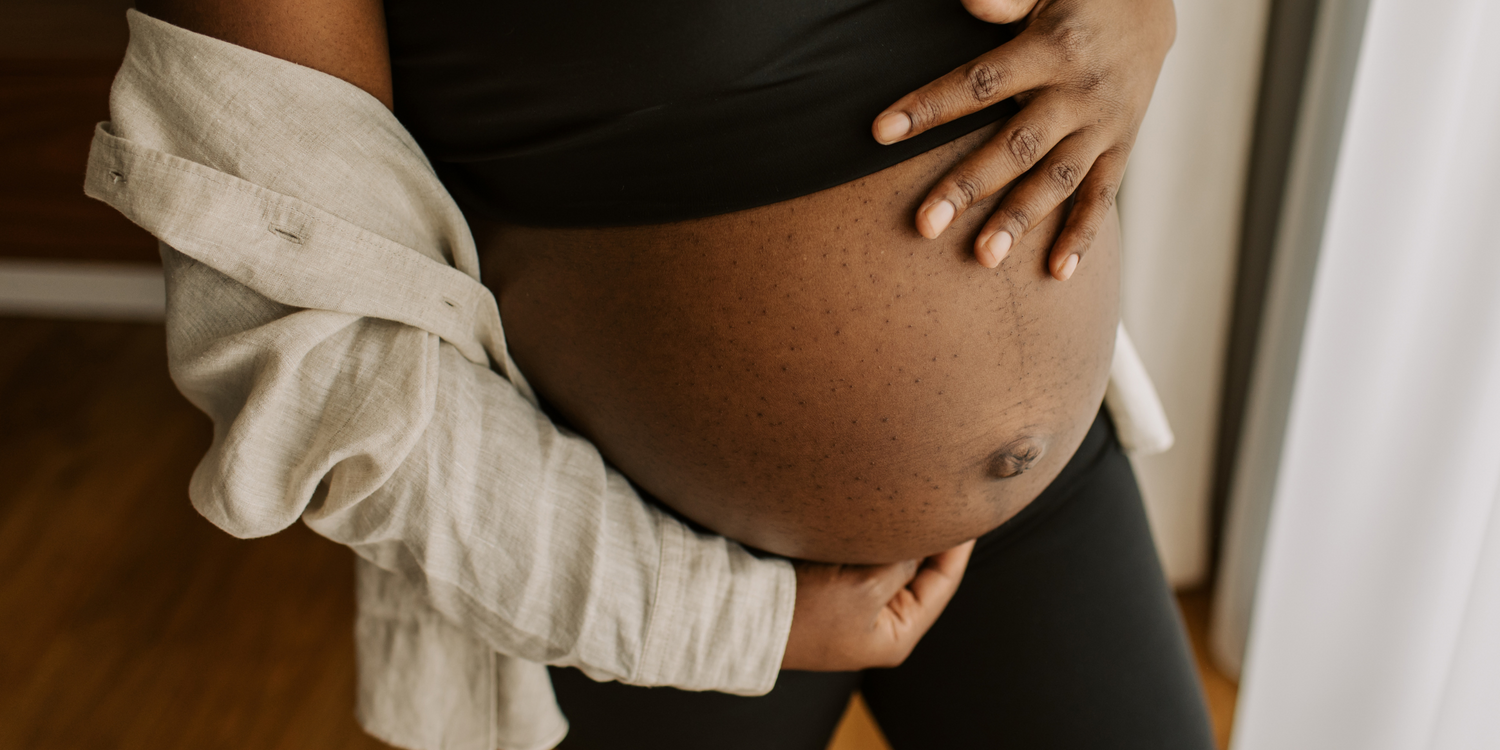Key Takeaways
- When will you feel your baby for the first time?
- This article explains when and how you can feel your baby's first movements, which factors influence the intensity and timing and how these special moments strengthen your bond with your baby.
- You will also find out how to watch out for changes in movement patterns and when it is advisable to consult your midwife or gynecologist.
Wondering when you'll first feel your baby move? These early baby movements are among the most exciting moments in pregnancy. As an expectant mother, it’s completely natural to eagerly await this special experience and to wonder what these movements will feel like.
This article explains when you can expect to feel the first movements and what they feel like—from the first gentle flutters to clear kicks. You’ll get important information about the factors that influence the timing of these first sensations and when you should contact your doctor. We’ll also show you the best positions to feel your baby move.
When Can You Feel the First Baby Movements?
Feeling your baby move is a special milestone in pregnancy. The timing varies from woman to woman and depends on several factors.
Timing for First-Time Mothers
If this is your first pregnancy, you’ll likely feel your baby move between the 18th and 22nd week of pregnancy. Some women don’t feel these first movements until around the 24th week. These early movements are very subtle and can be easy to overlook.
Timing for Experienced Mothers
In a second or subsequent pregnancy, you may recognize movements earlier, usually between the 16th and 18th weeks. This is because you know what to look for and your uterus becomes more responsive to movements with each pregnancy.
Factors That Influence Timing
Several factors can affect when and how strongly you feel your baby move:
Placenta Position: An anterior placenta (front wall of the uterus) can dampen movements.
Amount of Amniotic Fluid: With more amniotic fluid, movements may feel less distinct.
Baby's Position: Movements are more noticeable if hands and feet are positioned toward the belly.
Mother’s Body Sensitivity
Abdominal Wall Thickness
As the pregnancy progresses, the movements become stronger. By the 25th week, most mothers can feel their little "tummy athlete" quite well.
What Do the First Movements Feel Like?
The first baby movements are as unique as a butterfly fluttering in your belly. Many expectant mothers describe this special moment as the start of a deep connection with their child.
Descriptions of the First Sensations
Expectant mothers describe the first sensations differently. Here are the most common descriptions:
Like tiny bubbles popping
Gentle bubbling or gurgling
Fluttering butterfly wings
A light tickling in the belly
Development of Movements Throughout Pregnancy
As pregnancy progresses, your baby's movements become more noticeable. By the 28th week, gentle nudges turn into real kicks, and partners may even feel movements from the outside.
Toward the end of pregnancy, the movements change again. Since space in the uterus becomes limited, you’ll feel fewer large movements and more stretches. Sometimes these can even create small bulges on your belly.
Day vs. Night Differences
Your baby develops its own rhythm in the womb and is often more active when you’re at rest. This is because:
You notice the movements more in quiet moments.
Your movements during the day "rock" your baby to sleep.
Babies sleep up to 20 hours daily in the womb.
Interestingly, your baby may respond to outside stimuli like your voice, music, or gentle touches on your belly. These interactions can influence your baby’s movement and are a lovely way to bond before birth.
Encouraging and Sensing Baby Movements
To feel your baby’s movements more clearly, it’s essential to take time out from daily life. When you’re busy, even strong movements can go unnoticed.
Relaxation Techniques for Better Sensing
The following tried-and-true techniques can help you feel movements better:
Take regular breaks throughout the day.
Choose a comfortable position on the couch or in bed.
Place your hands gently on your belly.
Listen to relaxing music of your choice.
Focus consciously on your belly.
Communicating with Your Baby
Your baby can perceive sounds from the 16th week of pregnancy. Their reactions to your voice often show through gentle movements. Talking to your baby not only strengthens the bond but also supports early language development.
Your voice has a special impact, soothing your baby through the uterus and amniotic fluid. Interestingly, even when asleep, your baby may react to pleasant sounds like soft music or gentle touches.
Involving Your Partner
Pregnancy is a shared journey. Your partner can take an active role by:
Talking regularly to the baby, especially close to your belly
Joining you in evening belly massages
Following the baby’s weekly developmental milestones with you
The magical moments when movements are felt from the outside are especially exciting. These shared experiences strengthen not only the bond with the baby but also your partnership.
When to Worry
Regular baby movements are an important indicator of your baby’s well-being. Research shows that reduced movements can be a warning sign that should not be ignored.
When to Contact Your Midwife or Doctor
Contact a healthcare professional in the following situations:
If you haven’t felt movements by the 24th week. After the 28th week, seek immediate medical help if you notice a prolonged lack of movement or significantly reduced movements.
Studies show that reduced movements increase the risk of complications: the risk of growth restriction is 1.37 times higher, and the likelihood of labor induction is 1.8 times higher.
Signs of Reduced Baby Movements
The following changes should capture your attention:
A noticeable decrease or sudden change in usual movement patterns
No movements felt for over two hours
Noticeably weaker or rarer movements than usual
Sudden, unusually jerky or rough movements
Possible Examinations if Concerns Arise
If you have concerns, the following examinations may be conducted:
Initial Checks:
Recording of heart rate (at least 20 minutes)
Checking your baby’s heart rate
Further Examinations:
Ultrasound to check the baby’s size
Amniotic fluid level check
Specialized exams at a prenatal center
Important: Never ignore reduced movements and don’t wait until the next day. Trust your instincts—a timely check is better than waiting too long. Most women who experience reduced movements go on to have healthy babies, but timely checks can help detect potential complications early.
Conclusion
The first baby movements mark the beginning of a unique journey through your pregnancy. From the first gentle flutters to strong kicks, a special connection develops between you and your baby. These movements are as individual as you and your child—sometimes gentle and barely noticeable, then strong and powerful.
Your attentive observation of your baby’s movement patterns plays an important role in their healthy development. Trust your maternal instinct and don’t hesitate to contact your midwife or doctor if you’re unsure. With each passing day, not only does your baby grow, but so does your experience as a soon-to-be mother—a valuable time to cherish.
References & Literature
- Bundesverband der Frauenärzte e.V.: www.frauenaerzte-im-netz.de
- Bundeszentrale für gesundheitliche Aufklärung: www.familienplanung.de
- Deutscher Hebammenverband e.V.: Schwangerenvorsorge durch Hebammen. DHV-Expertenwissen. Hippokrates Verlag, 3. überarbeitete Auflage, 2014
- Gnirs, J. & Schneider, K.T.M.: Diagnostik der fetalen Bewegungsaktivität, fetaler Stimulationstests und der Komplexitätsanalyse des fetalen EKGs als Ergänzung der intrapartalen CTG-Überwachung. Gynäkologe 1996, 29:28-44
- Keirse, M.J.N.C. et al.: Effective care in pregnancy and childbirth. Oxford University Press, 1989: 477-492
- Schneider, H. et al.: Geburtshilfe. Springer Verlag, 2000
- Weyerstahl, T. & Stauber, M.: Duale Reihe – Gynäkologie und Geburtshilfe, Georg Thieme Verlag, 4. Auflage, 2013
You might also be interested in these articles
Schwangerschaft
Thyroid Levels and Pregnancy: Essential Information for Expectant Mothers6 Min. Lesezeit
Kinderwunsch
TSH levels and the desire to have children: the role of the thyroid gland in fertility11 Min. Lesezeit
Schwangerschaft
Pregnancy and breastfeeding: Can I get pregnant while breastfeeding?8 Min. Lesezeit





